|
Home →
Survival →
Traps
Apache Foot Hold Trap
by "Coon" |
| The Apache foothold trap was traditionally used to trap big game like deer. It consists of a
hole, a snare and wooden stakes. Although it was intended for larger animals I have found it
useful for trapping any animal such as fox, coyote and raccoon. Itís a good survival trap to know
due to its simplicity and adaptability to trap almost any animal.
PLEASE READ THE WARNING AT THE BOTTOM OF THIS PAGE. |
| |
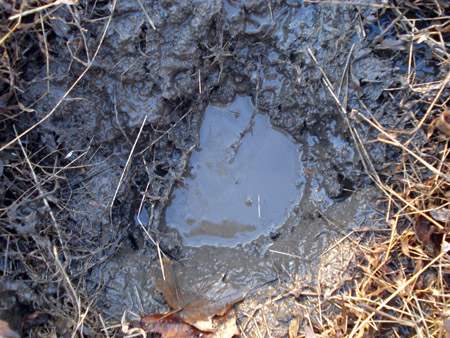 |
Dig a hole. I dig down to about 20 inches because I like it
to be deep for trapping deer. It can be slightly less deep depending on the animal youíre
trying to catch. It doesnít have to be very wide, just deep. Notice the water in my hole
- I dug into some wet mud because I noticed deer tracks there and mud is easier to dig
into. There was a lot of water in the hole but water isnít a problem, in fact it helps
camouflage the hole even more. Itís hard to tell exactly how deep it actually is because
thereís so much water in it. |
|
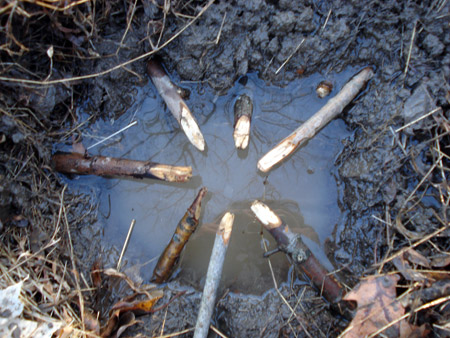 |
Next we put in the wooden stakes. These are the top stakes.
Underneath in the water is another set of wooden stakes - they look exactly the same as
the top. Simply pound the stakes in the side of the hole. I use about six. I used the
tracker knife to make them pointed.
The stakes should be roughly 12 inches long or more. These stakes will temporarily
hold the animal making it struggle more and making the snare tighten around its leg.
Although many people think the stakes are meant to hold the animal in the hole the entire
time until you check the trap, I have learned from experience that they manage their way
out of the stakes. |
|
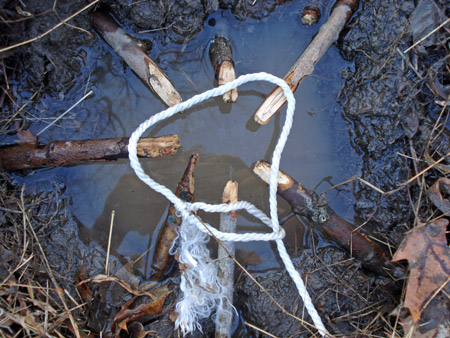 |
Make a snare using strong cordage. I used this white rope
for demonstration purposes for these photos. Simply lay the rope on top of the first set
of wooden stakes. Make sure you wrap the other end of the rope tightly around a healthy
tree.
Remember the stakes only help to get the snare tight around the animalís leg - the
rope is whatís holding it. With that said be sure your rope is strong and your knots
tight and you should be fine. |
|
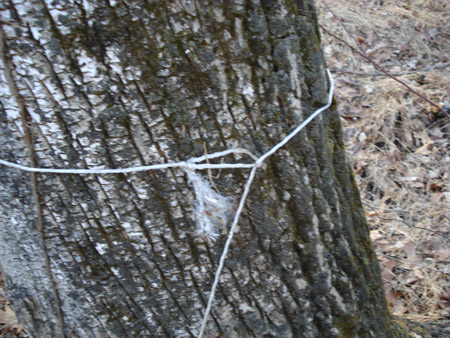 |
I like to snare the other end of the rope to a nearby tree
as shown in this photo. When the animal tries to run it makes the snare on its leg
tighter and the snare on the tree tighter. This method has never failed me even once.
Keep in mind you want the deer or other animal to have some room to move around a bit, so
donít make the rope too short or too long. |
|
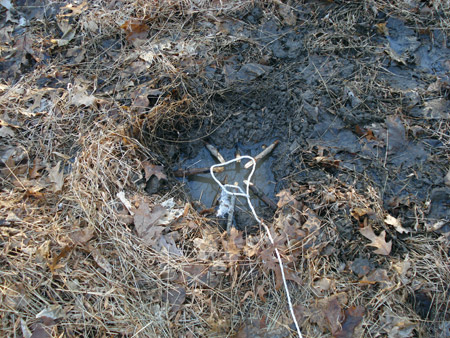 |
Here is what it should look like before you camouflage it.
Simply throw tall grass and dead leaves over it enough to cover the hole also remember to
cover the rope on the ground. |
|
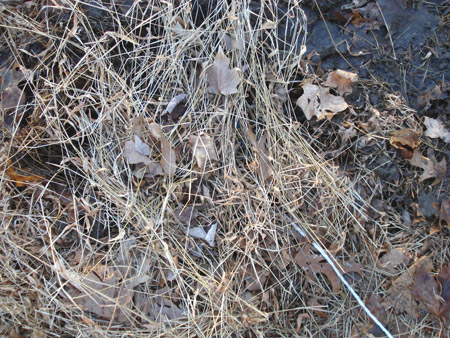 |
The hole is now camouflaged. Notice how I didnít put to
much on the hole, just enough to cover it. I covered the rope later on.
Now any deer walking by will walk into the hole and as it struggles its way out of the
stakes it wonít realize the snare has tightened around its leg. And you will have
successfully trapped a deer. Just be very cautious - the deer may be snared but itís not
dead! Donít get to close and kill it quick.
Questions? Email "Coon" at
vanhalen5150ja@aol.com. |
|
| |
| WARNING: Wildwood Survival and the
author take no responsibility for any injuries involving animals (or persons) you may
trap. A trapped deer can kick you hard resulting in serious injury!
This kind of trap can also seriously injure a person who
inadvertently steps in the camouflaged hole. Post a small sign warning people away
(deer don't read signs!).
Please use this information responsibly.
This information is for survival purposes only.
Follow your regulated hunting laws for deer; please do
not use this for poaching. If practicing take steps to ensure the deer does not get
injured. This trap can result in a broken leg. CAREFULLY release the deer you
trapped. If you cannot release it then kill it and let your local game commission
know of your mistaken kill. Better yet, don't practice with this trap. |
|
| |
|
|
| |